Garage Heaters: Evidence-Based Tips for Choosing the Best Heater
The issue of heating garages and utility rooms is relevant in the winter conditions of the northern regions.Demand creates supply, which is why the number of heating devices on the market is very large.
To choose the right heaters for a garage, you need to understand the principle of their operation, evaluate their efficiency, safety and the ability to solve the problem.
We have prepared an overview of the most popular solutions, outlined the pros and cons of different models, and also listed the basic rules for their operation. A step-by-step calculation of the heater power will help you choose the optimal heating device for the garage.
The content of the article:
Types of heaters and their features
The operating principle of the most ordinary heater is to transfer heat to the air near it. Such devices, typical for use in garages, have long been an electric stove, a gas stove or a potbelly stove. These are instruments and devices of the so-called direct heating.
Now you can purchase heaters that are superior to these devices in efficiency, ease of use and safety of use.
Let's take a closer look at the types of heaters that can be used in the garage.
Option 1. Oil heaters
A typical representative of ordinary heaters is an electric oil radiator.
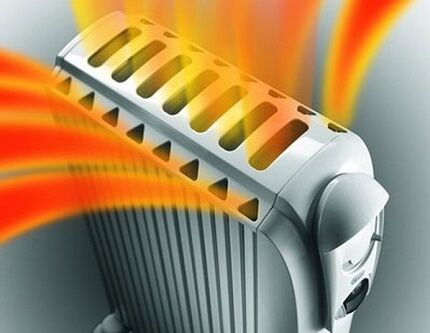
The device does not require special installation, has a very simple design, rarely breaks down, and you can do without special solutions to meet safety requirements.
The advantageous difference between an oil radiator compared to an ordinary electric stove is the larger heating surface area and, as a result, significantly greater heat transfer.
Oil radiators have long been used for heating rooms for various purposes, so there is wide range of options at the time of buying. It will not be difficult to choose a device of suitable power.
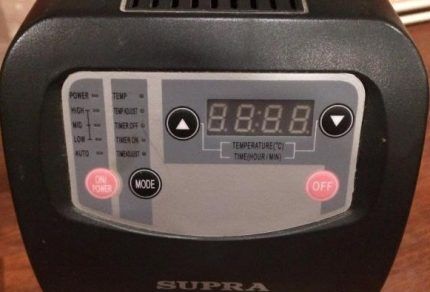
First of all, for use in a garage, you need to have a rheostat that regulates the temperature. When warming up the room, you can turn on the radiator at full power, and to maintain the temperature, reduce it to the required values.
It would not hurt to have automatic protection against overheating, as well as a sensor that fixes the tilt of the device and turns it off if it tips over.
Having a thermostat that determines the outside temperature is not a priority for the garage. But equipping it with a timer that allows you to turn on the device according to a schedule is a very convenient option if you need to warm up the garage in the morning.
Advantages of oil heaters for garages:
- is cheap;
- rarely breaks;
- difficult to damage upon impact.
A significant advantage of oil-filled devices is the safety of use in a technical room in which flammable substances are stored and used. If you accidentally touch it, you don’t have to worry that the body will crack, oil will spill, and rags, paper, etc. in the garage will ignite.
Among the disadvantages of oil-fired appliances, thermal inertia occupies a dominant place: the radiator itself must heat up before it begins to give off heat. The second impressive disadvantage is the uneven heating of the room.
Option #2. Convective heating devices
The operating principle of convective heaters (convectors) is based on the difference in air density at different temperatures. Cold air enters the device through the lower openings, heats up, becomes lighter, and exits through the upper openings.
According to this simple principle, natural air circulation occurs with its heating inside the device. The access of cold air to the heating elements increases their heat transfer compared to standard heaters.
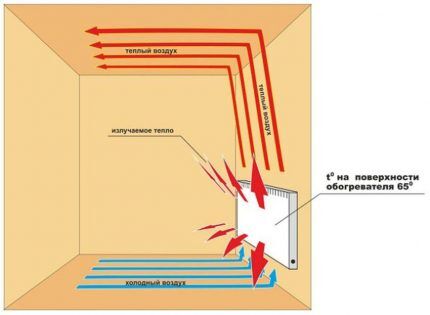
Convectors are usually mounted on walls because it is necessary to provide space for incoming cold air from below and outgoing warm air from above. The upper openings are equipped with special guide blinds, the position of which determines the direction of movement of the outgoing warm air.
According to the heating principle convective heating devices are divided into electric, gas and water varieties. Electric convectors are easier to install and operate than gas ones, but the power of the latter is higher.
A prerequisite for gas convective heaters is the installation of a hood to supply fresh air and remove combustion products. For small rooms, only gas convectors with a closed combustion chamber are used.
Advantages of convective garage heaters:
- the body of the device is not hot, so it is impossible to get burned when touched;
- almost complete fire safety for electrical devices;
- absence of complex structural elements that can fail.
Convective heaters also have disadvantages. For example, an electrical device is more suitable for maintaining temperature than for quickly heating a room.
If used in a garage, it will be necessary to regularly disassemble and clean the devices from dust.

Option #3. Electric fan heaters and heat guns
According to statistics, the share of fan heaters is almost half of the sales of all heating devices intended for domestic purposes.
The fan heater also operates on the principle of convective action, only the replacement of heated air with cold air occurs forcibly using a built-in device. As a rule, this is an ordinary blade fan.
At choosing a fan heater You need to pay attention to the type of heating element. Usually a nichrome spiral, heating element or ceramic plates are used.
Ceramic heating elements have a lower temperature, so less dust or other particles are burned and produce fewer burning odors.
There are two types of blade fans: axial and tangential. The tangential type of fan is less noisy and is equipped with column heaters that are installed vertically. Their cost is more expensive than ordinary horizontal fans.
When using fan heaters for garages, the issue of having a filter on the back surface of the device is relevant. There must be a filter.
It’s rare that a garage is kept clean, and heavy dust getting inside the device will quickly damage the heating element and fan. It will become clogged with dust quite quickly, so cleaning the filter should be easy, and replacement cartridges should be cheap.
Electric heat gun – this is the same fan heater, only with high power (from 3 kW). When choosing such a serious device, it is necessary to take into account the rated voltage, because powerful heat guns are designed for 380 volts.
It is also necessary to correctly evaluate the ability of the electrical wiring and outlet to withstand high power voltage. Quite often the option of using a combination of a liquid fuel electricity generator complete with an electric gun is used.
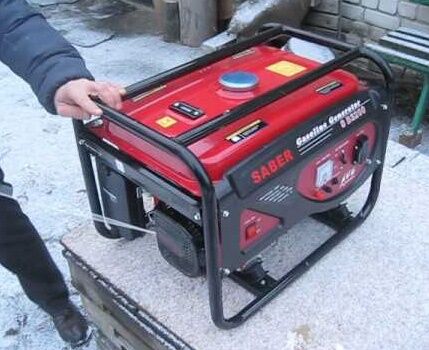
Advantages of electric fan heaters for garages:
- are cheap;
- are equally capable of heating and maintaining temperature;
- distribute heat evenly throughout the garage.
The disadvantage of using electric fan heaters in arranging a garage is the need for effective protection against dust getting inside the device. During operation, the device creates noise and stimulates air movement with harmful dust rising.
Option #4. Diesel and gas heat guns
Heaters of this type are mainly used when it is necessary to quickly heat a room. Principle of operation diesel And gas guns similar to electric ones, only heating occurs due to the combustion of fuel or gas.
The fan of such guns also runs on electricity and, thus, access to electricity is still necessary. A diesel heat gun is the most expensive, but also the most economical installation of all other types of heating.
There are two types of guns:
- direct heatingwhen combustion products enter the room along with the flow of warm air, which is unacceptable for small areas;
- indirect heatingwhen the combustion chamber is isolated from the heated air and combustion products have a separate outlet.
A gas heat gun is also economical, but combustion products enter the heated room. In addition, such a gun burns a lot of oxygen.
Therefore, from the standpoint of people’s safety, it is very important to know what the main function of the room is: if people work in the garage, then it is better not to use a gas heater of this type.
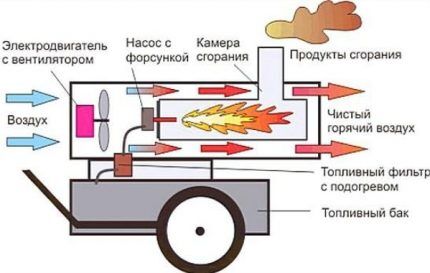
Advantages of non-electric heat guns:
- are equally capable of heating and maintaining temperature;
- distribute heat evenly throughout the garage;
- Using diesel fuel and gas is much cheaper than electricity.
It is worth noting the disadvantages. By analogy with other types of heat guns, diesel and gasoline equipment burns oxygen. Creates noise during operation, stimulates air movement, which raises dust in the garage.
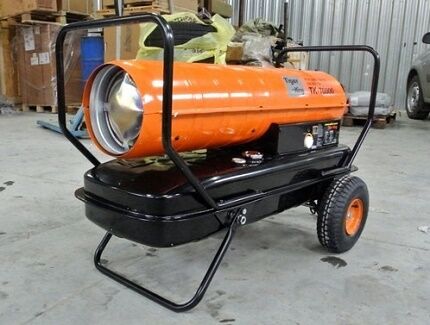
Option #5. Infrared devices
Infrared (IR) heaters use the same operating principle as the Sun heats the Earth. Long waves of the radiation spectrum hit objects and increase their temperature, and they already heat the air.
The designs of such devices may differ, but the main part of infrared heaters is still the emitter.
Heaters with a radiating surface temperature of up to 600 degrees Celsius are intended for domestic purposes. In addition to electric IR heaters, there are also gas heaters, but their use in poorly ventilated rooms is contraindicated.

Modern electric IR heaters use the following types of emitters:
- Metal. Low-temperature heating element made of stainless steel in combination with aluminum radiating plates with anode coating. The simplest and most reliable heating design. Cracking occurs when heated and cooled.
- Ceramic. A metal spiral heats a ceramic panel coated with black glaze. Not very high efficiency.
- Micathermic. The wave-emitting plates are covered with mica. Very low surface temperature of radiant panels - only 60 degrees. Relatively high cost compared to the previous two options.
- Quartz. The tungsten filament is enclosed in a vacuum tube made of quartz glass. Like all lamps, it requires careful handling.
- Halogen. The tube does not contain a vacuum, but an inert gas. The filament temperature is higher than that of a quartz heater, but there is a noticeable glow.
- Carbon. The carbon filament is enclosed in a vacuum tube made of quartz glass. Higher efficiency than the previous two tube heaters, but also higher cost.
Typically, IR heaters with emitters based on aluminum plates are used for heating garages.
Firstly, they are cheaper.Secondly, they are very reliable and last a long time. And lastly, they are resistant to mechanical stress (shocks), which is important for garage conditions.
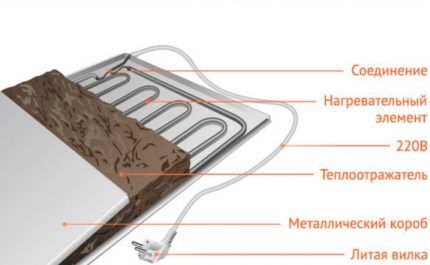
The temperature of aluminum plates when heated, as a rule, does not exceed 300 degrees Celsius, which is lower than the ignition temperature of paper and wood. Therefore, the emitter itself meets fire safety requirements.
At such temperatures, oxygen does not burn out either, so the heater can operate for a long time without harm to humans.
When choosing a heater with a plate emitter, you need to pay attention to the thickness of the anode layer. It is desirable that it be at least 25 microns. The body of the heating element must be made of stainless steel, then it will not rust when used in damp rooms.
Advantages of IR garage heaters:
- according to the owner’s decision, we implement uniform heating of the garage or heating of a separate area, for example, a work area in a garage-workshop;
- You can heat areas of the garage that are difficult to reach for other devices, for example, under the hood of a car.
The disadvantage of IR garage heaters is that these devices are more suitable for maintaining temperature than for quickly warming up a room.
Regarding infrared heaters, there are many speculations regarding their harm to the human body.
Option #6. Heating cables
At first glance, the idea of organizing a heated floor for a garage may seem overly luxurious, but in one case it works very well. We are talking about solving the problem of starting a car in extreme cold.
Can be arranged electric heated floor only under where the car is parked and turn it on in winter when there is severe frost. Since a heated floor does not emit a very large amount of heat, it is necessary to limit the heating zone.
In this case, you need to put a cover over the car so that it reaches the garage floor on all sides. Then the heating zone will be limited to the space under the machine and the machine itself.
There will be no air movement between the heating zone and the rest of the garage, and heat loss through the cover with a temperature difference of no more than 20 degrees will be insignificant.
Using this method, you can achieve a completely comfortable temperature environment for a car within 10-15 degrees Celsius below zero, at a temperature in the garage of minus 30-40 degrees.
The advantage of heating cables for a garage is that the power consumption of the heated floor is low and any wiring can withstand it.
The disadvantage of heating cables for garages is that proper work laying heated floors quite complex. Installing heated floors in a garage is the most difficult job compared to installing other types of heaters.
Rules for operating different types of heaters
Electric heating devices are safer to use than gas or liquid heating devices.
When operating electric heaters of any type in a garage, in addition to the basic rules for working with electrical appliances, you must pay attention to the following:
- the ability of the outlets and the electrical network connected to the garage to withstand the power of the heater;
- increased humidity in the garage during the transition from negative to positive temperatures.
When operating gas, diesel and gasoline types of heaters, you must pay attention to the following:
- possibility of gas leakage or gasoline evaporation;
- the need to take increased fire safety measures due to the presence of open fire;
- the likelihood of poisoning by combustion products;
- possibility of oxygen deficiency in the garage.
Focusing on saving money on heating the garage, you should prefer diesel or gasoline options. If safety is the basis of your choice, it is advisable to prefer electrical appliances.
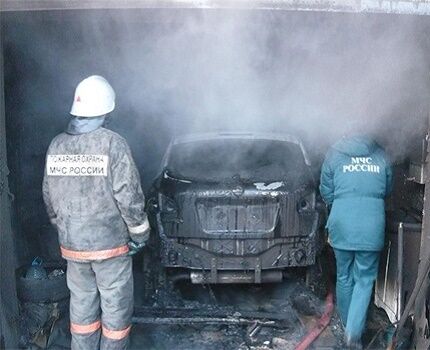
Calculation of thermal power of the heater
There is a formula for calculating the required power to maintain a constant room temperature:
N = V x dT x K,
Where:
- N – power (kcal/h);
- V – room volume (cubic m);
- dT – temperature difference between indoors and outdoors;
- K – empirical coefficient of heat dispersion (dissipation).
Coefficient K takes the following values:
- 0,6 – 0,9 - with high thermal insulation;
- 1,0 – 1,9 — with average thermal insulation (concrete garages with insulated doors and no special supply ventilation);
- 2,0 – 2,9 - with low thermal insulation (concrete garages with metal doors and ventilation holes);
- 3,0 – 3,9 - without thermal insulation (metal garages).
The conversion formula for kcal/h and W is as follows:
1 W = 0.86 kcal/h or 1 kcal/h = 1.163 W.
Let's solve an example. Given a standard cooperative shell garage 6 x 3 x 2 meters. Good insulation: behind, on the right and on the left - similar garages; 30 cm of snow on top of the roof; the gates are insulated with foam plastic; The hoods are sealed with foam plastic for the winter.
At a temperature of -35 degrees, it is necessary to reach a temperature in the garage of -10 degrees and maintain it for three hours to start a diesel car. We use a fan heater as a heater.
Solution:
- V = 6 x 3 x 2 = 36 cu. m;
- dT = 25 degrees;
- K = 1.5;
- N = 36 x 25 x 1.5 = 1350 kcal/h = 1570 W.
This is the value at which the temperature in the garage will be kept within -10 degrees. To heat to this temperature, it is necessary to use twice the power for an hour.
Answer to the problem: for one hour the power should be 3 kW, for the next 3 hours the power should be 1.5 kW.

A convincing guideline is prices
The price of a heater of any type depends on its power, functionality and manufacturer.
To compare different heaters, we will take as mandatory parameters a maximum power of 2.8 kW, the presence of a rheostat for power adjustment and basic safety features that are relevant for using the device in a garage. For electric models, a voltage of 220 Volts is a prerequisite.
Oil heater Termica Comfort 1120 (China). Three levels of power adjustment (2900 W, 1500 W and 1000 W). Overheat and tip-over shut-off function, frost protection. There is a small fan available. Price 3,300 rub.
Electric convector AEG WKL 3003S (China). Maximum power 3 kW. The presence of a thermostat, protection against overheating and capsizing. Floor or wall installation. Price 5,700 rub.
Gas convector Bartolini Calorama FB 4000 (Italy). Maximum power 4 kW. Closed combustion chamber, electric ignition from batteries. Price 12,900 rub.
Electric fan heater Comfort TPK-3000 (Russia). Two levels of power adjustment (3000 W and 1500 W). Ceramic heater, overheat protection. Price 3,700 rubles.
Gas gun Ballu BHG-10 M (China).Maximum heating power 10 kW, power adjustment using a gearbox. Fan power consumption 32 W. Price 4,900 rubles.
Indirect action diesel gun. Maximum heating power 25 kW, fan power consumption 290 W. Thermostat with automatic shutdown support. Price 28,500 rubles.
Infrared heater NeoClima Shaft-3.0 (Greece). Two levels of power adjustment (3000 W and 1500 W). Quartz heating element, thermostat. Wall and floor installation. Price 3,600 rubles.

Conclusions and useful video on the topic
Option for equipping a garage with infrared heaters:

How to heat a garage with a diesel heat gun:

There is no type or model of heater that is ideal for all garage heating needs. Depending on the conditions, you can use various, including combined, approaches to solving this problem.
A large selection of heaters available for purchase allows you to provide high-quality heating for parking a car and comfortable work in the garage in almost any conditions.
Looking for a garage heater? Or do you have experience using such heating devices? Please leave comments on the article and share your impressions of using heaters.
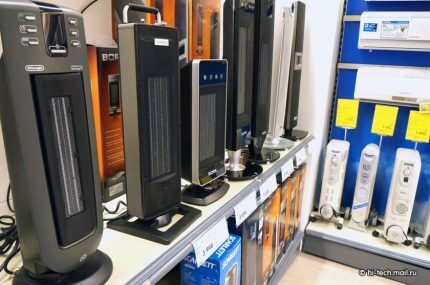




I have a garage at home since before I was born. And of course there was no heating there. Last winter there were severe frosts, and even standing in the garage, the car froze and would not start. Then I decided that I needed to come up with something for heating. Potbelly stoves disappeared immediately, due to their unsafe use. I started researching and found different options. In the end, I decided to go with a gas convector, since gas is the cheapest fuel at the moment. The project is already ready, and specialists will soon begin installation.
Of course, there are always options. The first is to sheathe the inside surface of the garage with thermal insulation and install a UFO electric heater. This is if the garage is located remotely from the house. And if the garage is located on the territory of a country property, then the boundaries expand. You can install heating pipes (steam or gas heating) or install a regular coal stove or “potbelly stove”. My garage is located in the courtyard of my house. In winter, I use the UFO electric heater: it’s a convenient thing, it quickly warms up the garage and the air doesn’t scorch, and most importantly, there are no hassles in the form of heating systems or furnaces.
Most of the methods in your material are too expensive and confusing. Who is this intended for? Apparently, for people who have a large plot of land with a garage. For the majority of the population in our country, garages are small buildings in garage cooperatives. I'm looking for a way to heat just such a garage. Moreover, I’m not going to heat it to room temperature, the main thing is that my hands don’t freeze and I can safely tamper with the car in winter.
Why do you write that the article only covers expensive garage heating options? I saw both complex solutions for years (expensive) and budget options.What's wrong with the options for gas and electric infrared heaters? The solution is not expensive and allows you to work comfortably in the garage even in winter.
I have an IR heater BALLU BIH-AP-2.0, the price is 5200 rubles, I installed it above the workbench, I made the mount myself. In general, I have a potbelly stove in the garage, which I made myself during my vacation about two years ago. I had the materials, so this decision actually cost me pennies. And I turn on the IR heater while the stove is heating up or in the fall, when it’s too early to heat the stove.